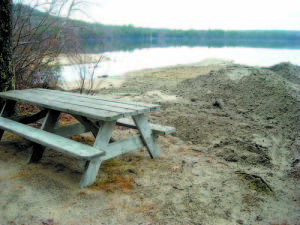Crescent Lake beach gets a facelift

On Friday, this mound of wet sand had been removed from Crescent Lake, and will be used to restore the town’s public beach. The Department of Environmental Protection (DEP) approved the project via a permit-by-rule. (De Busk Photo)
By Dawn De Busk
Staff Writer
CASCO — People who frequent the public beach on Crescent Lake may have noticed the buildup of sand in the swimming area.
For families with toddlers, the shallow water can be viewed as a big plus. For residents desiring an unencumbered swim, the walk alone to deeper water can be a workout.
To anyone who has spent time at the beach, the pros and cons are obvious.
But, one would have to be a botanist to notice how the plants and trees around the shoreline are struggling — with roots exposed by the displacement of sand and soil.
According to Casco Code Enforcement Officer Don Murphy, that is the main reason the town has been allowed to restore its beach.
The removal of sand from under the water is permissible through the permit-by-rule regulation from the Department of Environmental Protection (DEP).
A permit-by-rule sidesteps the paperwork and application process, allowing work to begin once a notification is filed with the DEP, Murphy said.
“The reason we moved so quickly is that the lake was at a historic low,†he said.
“We wanted to get the sand out of the water to restore the shoreline,†he said.
Also, on the right side of the beach, riprap was placed to keep erosion at bay.
In recent weeks, an excavator has been parked at the town beach on Crescent Lake. Gary Drew, who owns Drew Excavation based in Otisfield, was hired for the job. Drew is Shoreland Zone certified.
According to Murphy, the excavator is allowed to park on the spit of sand, while the arm scoops up bucket-loads of sand. The machine itself cannot enter the water; and, the operator must be vigilant in watching for any oil leaks, Murphy said.
Only sand can be removed, and re-used for the beach restoration, he said.
Any muck or mud dug up from the lake bottom must be removed from the site, he said. Also, if aquatic plants are present, those plants cannot be disturbed.
Luckily, for the Town of Casco, there are no aquatic plants growing in the swimming area — either because of the water currents or because of the foot traffic over the years, Murphy said.
It is not permissible to import sand to an area for a beach restoration project, he said. Imported sand might have a different pH-balance than sand that was part of the terrain around the lake, he said.
Years ago, there had been some flooding that occurred before the town fixed the culvert, which runs under Edwards Road. The sand that washed away during the flood event had exposed the roots of the trees. The water undermined the roots of the bushes and vegetation growing along the shoreline.
The problems stemming from this year’s low water levels simultaneously offered some opportunities to fix them, Murphy said.
The low water exposed a spit of sand from which an excavator could work, he said.
For the benefit of the public, Town Manager Dave Morton mentioned the undertaking during a recent Casco Board of Selectmen meeting.
“If folks see an excavator adjacent to the beach, don’t be alarmed. It is a town-approved project,†Morton said.

